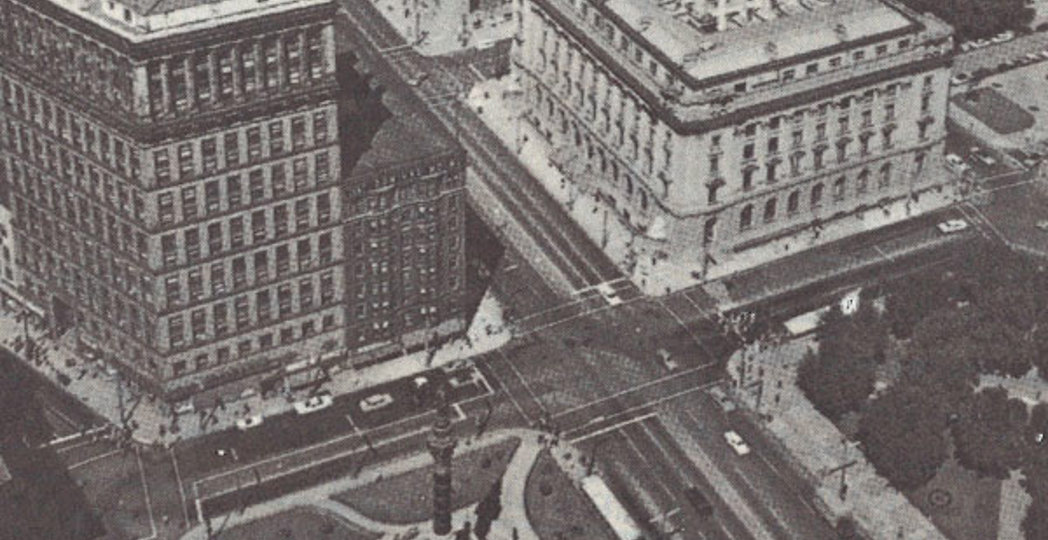Disturbing Observations
by Dick Feagler | Jan. 28, 2009 | 5:00 AM

What it has become is a monument to fear and hopelessness. Its very name is meaningless now. Terminal Tower. Strange name for a building that functions as neither terminal nor tower. The kindest thing to do, probably, would be to forget about it.
But that isn’t easy. It’s still on the post cards. Photographers, sent to get a picture of some visiting notable, hunker down to get a shot with the Terminal Tower in the background. That’s because it is the single most graphic symbol of Cleveland.
Your kids know about it, too. Driving in on the freeways from the suburbs, they strain to catch a first glimpse of it from back-seat windows. In a city where most of the downtown buildings look like middle-size Lego blocks, the Terminal Tower is the dominant personality — like a Broadway actor in a roomful of bank managers. Eyes stray to it. It is urbane; it breathes the old promise of Metropolis.
Finally, there are the memories. Memories of the days when it actually was a terminal tower.
Trains aimed in exotic directions beneath the marble floor of its station concourse. Schoolchildren riding fast elevators to its peak — their stomachs tickling from the zoom of the ascent — to gaze at the panorama of the city, the lake. “Hey, I can see Canada!” the kids would claim. “The people looked like ants,” they would say, back with the other kids on their block. “You could see the Stadium outfield.” And you could. Green as an emerald.
The trains died first — planes killing off the good ones, the klutzy Amtrak moved at the demands of railroad moguls to an Amshack somewhere behind City Hall. Except for some Rapid Transit traffic, that move made meaningless the building’s first name. Now it was mainly Tower.
And then in August 1976, Ashby Leach of West Virginia, with a cause in his pocket and a gun in his hand, walked into the offices of the Chessie System high in the tower, and terrorized the place for a day. He claimed to have complaints about the way Chessie management treated Vietnam veterans, and he came riding into Chessie on the Terminal observation deck elevator — a 1970s
Jesse James seeking the great prize of the decade: notoriety.
And that was the end of the Terminal Tower as once this city knew it. In order to get to the observation deck, you had to take one elevator to the thirty-second floor, then switch to another which took you to the top. The Chessie System occupies floors thirty-two to forty-two. There was no way to prevent some crazy from boarding this second elevator, under the guise of going to the top of the Tower, and getting off at any Chessie floor instead to what? Rob? Rape? Steal? Pillage? After Ashby Leach, who knew?
So the Chessie people closed off the observation deck. They knew they’d take some media flak for this and they did. But not much. There were too many things locally for the media to be dismayed about to allow lingering dismay about the Tower closing.
“One of the things Mayor Kucinich said he was going to do if elected was reopen the observation deck,” says Milt Dolinger, Chessie director of public relations. “So after his election, we wrote a letter proposing that our security people sit down with his security people and figure out a way to do it. But we never heard anything.”
And that is how matters stand. Ashby Leach, at last report, was out on bond awaiting an appeal on the conviction for his Tower caper. He is working in his father’s lumberyard in Huntington or so it is said. But a case might be made for the fact that he is still here, holding the top of the town’s tallest building in a paralyzing grip — a sort of theoretical King Kong, clinging to the Tower and terrifying us yet.
Yes. And the Terminal Tower remains a symbol still. What it symbolizes now is not the stuff of post cards. What it symbolizes now is urban despair. The feeling that no solution can be found for certain kinds of problems. That we have become a city afraid of dark corners and people on elevators. A city of locks and cynicism. Of distrust and paranoia.
The observation deck has become a Chessie conference room. We tried to get a picture of it but were told that such an enterprise would be against Chessie rules. Chessie was sorry, we were told, but that was the way it is.
If someone were to make a new post card of Cleveland, a post card featuring the new Terminal Tower, that would be an excellent sentiment for these times. “Cleveland, Ohio. We are sorry, but that’s the way it is.”
Our memories made us curious. What has happened, we wondered, to that magnificent view — the view of children’s daydreams?
“Well,” Dolinger said. “We use the conference room to show movies. So we had to block some of those windows off.”
This story originally appeared in Cleveland Magazine's March 1979 issue.
Trending
-
1
-
2
-
3
-
4
-
5










